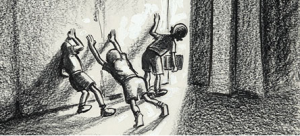Illustration downloaded from http://www.loc.gov/teachers/classroommaterials/presentationsandactivities/activities/political-cartoon/about.html
Education is one of the foundations of Canadian society. If you are wondering why your board is addressing issues of equity and inclusion recently, a policy/program memorandum has impacted the way Ontario public school boards are conducting their business of education.
Through the Policy/Program Memorandum No. 119, Developing and Implementing Equity and Inclusive Education Policies in Ontario Schools, it is stated that there is a need for our “publically funded education system to support and reflect the democratic values of fairness, equity, and respect for all” (Ministry of Education, 2013).
The Ministry of Education recognizes factors such as race, sexual orientation, physical or mental disability, gender, and class can create barriers to learning. There is evident that some groups of students continue to encounter discriminatory barriers to learning. Research shows that when students feel connected to teachers and other students, they do better academically (Goleman, 2006).
Please refer to Barriers to Student Learning – An Overview for a more details outlined in Through Policy/Program Memorandum No. 119.
So what does this mean to teachers?
School boards must seek out barriers to learning for all students. Teachers therefore must also address barriers to learning due to factors such as race, sexual orientation, physical or mental disability, gender, and socioeconomic status.
Through Policy/Program Memorandum No. 119, school boards, and teachers, must address barriers to learning that fall within prohibited grounds of discrimination set out in the Ontario Human Rights Code.
There is significant evidence to show that Black youth face significant barriers to learning within their schools. School boards such as the Toronto District School Board and the Peel District School Board have identified barriers to learning for Black youth who face systemic discrimination and who do not feel connected to their teachers or their school communities.
In developing and implementing equity and inclusive education to address Memorandum Number 119 (2009) education policy within Ontario, the Peel District Board of Education (PDSB) has identified a part of their student community who is experiencing systemic barriers to learning. These barriers to learning are supported through research that shows that black male students feel excluded, have fewer opportunities, and experienced an achievement gap in their learning. Further, research also shows that these barriers to learning are rooted in systemic biases and in negative teacher and peer perception of Black males identity and ability (Peel District School Board, 2018). These biases result in an over representation of levels of suspension and expulsions and lower levels of representation in gifted programs and high school completion (Maynard, 2017).
System-wide, cultural responsive pedagogy and practices are being put into place to have Black male students feel more included in meaningful curriculum and instruction. This curriculum should be reflective of Black voices and help students see themselves within the lessons. This curriculum should address Black culture from all over the world, and not just from “Jamaica” (Peel District School Board, 2018).
In order to integrate the experiences of Black Canadians into the curriculum, the PDSB is providing instructional resources to be embedded into core courses and through inquiry as well as classroom resources to reflect the student body (Peel District School Board, 2018). Teachers and teacher librarians will play a critical role in building culturally responsive schools. Further, purposeful assessment and student voice will to integrated into school practices. This action plan is also embedding equitable and inclusive practices in board policies and programs while identifying and removing discrimination, biases, and system barriers to the success of Black male students. There has been a system wide leadership commitment to this initiative thus changing the board’s climate and the prevention of discrimination and harassment of Black male students’ board wide. To ensure accountability, the PDBS will be tracking the impact on data of expulsion and suspension rates, gifted student numbers, and graduation rates in Black male students ensure accountability and transparency.
In the next few blogs, I will further address some of the barriers to learning that students face based on their race, sexual orientation, disability, gender, and socioeconomic status.
If you would like me to address barriers to learning for a specific student group, please provide a suggestion below.
Collaboratively yours,
Deb Weston
Note that, although I do not have any direct experience with the barriers to learning addressed in this blog, I do identify as an educator who advocates for equity and for all students, especially when it comes to breaking down barriers to learning.
References
Caton, M. (January 31, 20198). Ontario Black Youth Action Plan aims to break down barriers, Windsor Star. Downloaded from https://windsorstar.com/news/local-news/ontario-black-youth-action-plan-aims-to-break-down-barriers
Goleman, D. (2006). Social Intelligence: The New Science of Human Relationships.-New York, NY: Bantam Dell, A Division of Random House.
Gordon, A. (October 2, 2017). Summit on barriers faced by Black male students comes to Toronto, Toronto Star. Downloaded from https://www.thestar.com/yourtoronto/education/2017/10/02/summit-on-barriers-faced-by-black-male-students-comes-to-toronto.html
Maynard, R. (2017). Canadian education is steeped in anti-black racism, The Walrus Magazine.
Ontario Ministry of Education. (2013). Policy/Program Memorandum No. 119: Developing and Implementing Equity and Inclusive Education Policies in Ontario Schools, Government of Ontario. Toronto.
Peel District School Board. (2018). We Rise Together: The PDSB action plan to support Black male students. Peel District School Board of Education.






